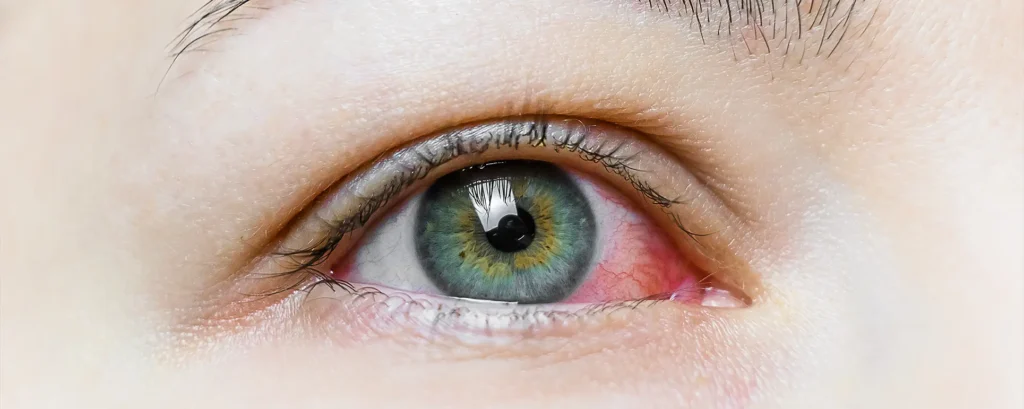Understanding the Normal Recovery Process First
Before jumping into what’s concerning, let’s look at what’s generally considered normal. After your cataract operation, your eye may feel a bit gritty or itchy. Mild redness, slight tearing, and blurred vision in the first few days are also common. These symptoms usually settle as the eye heals. You may also notice a flicker or glare in certain lighting – this is your eye adjusting to the new lens.
For many people, vision begins to improve within 24–48 hours, though some can take a bit longer depending on the type of cataract, how dense it was, and whether any other eye conditions were present before surgery.
If you’ve had YAG laser capsulotomy later on for posterior capsule opacification, that’s a separate situation — this article focuses on the recovery following the initial cataract surgery.
1. Severe or Worsening Eye Pain

Some discomfort is expected after surgery — like a scratchy or dry feeling — but sharp, worsening pain is not. If you feel intense pain that doesn’t respond to over-the-counter painkillers, or it keeps you awake at night, that’s a concern.
Pain could suggest complications such as increased eye pressure, infection, or inflammation. In rare cases, it could signal a more serious problem like a posterior capsular rupture or even a retinal tear.
Don’t wait to see if it improves on its own — contact your clinic straight away.
2. Sudden Vision Loss or Dramatic Blurring
A bit of blurriness right after the operation is normal. Your eye needs time to heal and adjust to the intraocular lens. However, if you notice a sudden drop in vision, or your vision becomes cloudy or foggy out of the blue after initially improving, that’s a red flag.
This could be caused by several issues:
- Retinal detachment
- Endophthalmitis (a severe infection inside the eye)
- Macular oedema (swelling at the centre of your retina)
Each of these conditions requires urgent medical treatment, so don’t delay if your vision seems to be going backward.
3. Increasing Redness or Swelling

Mild redness in the white of the eye is very typical and usually resolves within a few days. However, if the redness worsens or spreads, and especially if it’s combined with pain or vision problems, it may be a sign of intraocular inflammation or infection.
Likewise, swelling of the eyelid or around the eye should start to reduce fairly quickly. If it increases — or appears out of nowhere after the first few days — get in touch with your surgeon. Persistent swelling can sometimes be linked to allergic reactions to eye drops, or to more serious issues like cystoid macular oedema.
4. Light Sensitivity That Gets Worse
Some light sensitivity is common for a few days after surgery. You’ve had an intense light shone into your eye, and your brain is adjusting to the new clarity the artificial lens provides. But if this sensitivity gets worse instead of better, or if light starts to hurt your eye, it could be a symptom of inflammation or infection.
Photophobia is especially worrying if it’s combined with tearing, headaches, or blurred vision. It’s often a sign that something deeper within the eye is irritated or inflamed — and this is not something to ignore.
5. Seeing Floaters or Flashes of Light
You might already have had a few floaters before your cataract surgery. These are the little spots or cobweb-like lines that drift around your vision. But if you suddenly start seeing a shower of new floaters, or flashes of light like lightning streaks, this could indicate a retinal tear or detachment.
Retinal detachment is one of the more serious complications that can follow cataract surgery — and it doesn’t always happen straight away. It can occur days or even weeks later, so don’t assume you’re in the clear just because it’s been a while.
Call your eye specialist immediately. Prompt treatment can save your vision.
6. Halos, Rainbows, or Starbursts Around Lights
A lot of people notice halos or starbursts around lights at night after cataract surgery — particularly if they’ve had a multifocal or toric IOL. These are often temporary and settle over time as your brain learns to adapt.
However, if these visual effects start suddenly, become more intense, or are paired with eye pain or pressure, it could indicate a corneal issue or a spike in intraocular pressure. Very high pressure can damage the optic nerve, so this isn’t something to brush off.
If you wear glasses, check that it’s not just a smudge on your lens — but if the effect persists, call your surgeon.
7. Nausea or Vomiting with Eye Discomfort

It might seem odd, but nausea and vomiting can be associated with high eye pressure. When pressure spikes suddenly — especially within the first day or two after surgery — it can cause feelings of sickness, even if the eye itself doesn’t feel that painful.
If you feel sick, dizzy, or have a headache along with eye discomfort, don’t wait to see if it passes. These could be signs of acute angle-closure glaucoma or postoperative pressure issues, which require quick treatment.
8. Sticky or Mucky Discharge
A little crusting around the eyelashes is completely normal in the first day or two. But if you notice yellow, green, or thick discharge, especially if it’s accompanied by pain, swelling, or blurred vision, it could be a sign of conjunctivitis or even postoperative infection.
Don’t try to treat this yourself with over-the-counter drops. Some infections after cataract surgery, such as endophthalmitis, need strong antibiotic drops or even injections inside the eye. Early treatment makes a huge difference.
9. Eyelid Drooping (Ptosis)
Sometimes after surgery, especially if you had a speculum holding your eyelids open, your upper eyelid may droop a little. In many cases, this improves with time. But significant or worsening ptosis might point to nerve or muscle issues caused by anaesthetic, swelling, or even trauma.
If your droopy eyelid is affecting your vision or worsening, it’s worth flagging with your surgeon. It might need further investigation, especially if it doesn’t improve after a few weeks.
10. Feeling Like a Shadow or Curtain Is Falling Over Your Vision
This particular symptom — the sensation of a dark shadow or curtain moving across your vision — is a classic warning sign of retinal detachment. It’s a medical emergency. Don’t wait to see if it clears. Go straight to your nearest emergency eye department or contact your surgeon immediately.
Time is critical when it comes to retinal problems. The sooner you’re treated, the better your chances of preserving your sight.
11. A Drop in Vision After a Period of Improvement
You might find that your vision improves dramatically after cataract surgery — only to get worse a week or two later. This can be confusing, but there are several reasons it might happen.
The most common is posterior capsule opacification — a clouding of the membrane behind the new lens implant. This isn’t dangerous and can be corrected quickly with a YAG laser procedure.
However, a drop in vision can also signal inflammation, fluid buildup, or retinal problems. It’s worth getting checked even if you suspect PCO, just to rule out anything more serious.
When in Doubt, Get It Checked
It’s always better to be safe than sorry. If something feels wrong, even if it’s not on this list, pick up the phone and call your eye surgeon. They would much rather reassure you than miss an early warning sign of something serious.
Don’t rely solely on online searches or advice from friends. Every eye is different, and what was normal for someone else might not be for you.
The Role of the Follow-Up Appointments
You’ll typically have a post-op check-up within 24–72 hours of surgery, then another at around four to six weeks. These appointments are crucial. They allow the surgeon to monitor for silent problems, such as rising eye pressure or inflammation that you might not feel.
Don’t skip these follow-ups, even if you’re feeling fine. And if you notice a red flag symptom between visits, don’t wait for the next scheduled appointment — call immediately.
What You Can Do to Prevent Complications
While not all issues are preventable, a few things can lower your risk of post-op problems:
- Follow the drop schedule carefully. Don’t stop early unless told.
- Avoid rubbing or pressing on the eye.
- Wear your protective shield at night during the first week.
- Keep water, soap, and dust out of the eye.
- Avoid strenuous activities and heavy lifting.
- Don’t drive until cleared by your surgeon.
Good hygiene and compliance with instructions go a long way in keeping your recovery smooth.
FAQs: Red Flags After Cataract Surgery
- How much pain is normal after cataract surgery?
It’s normal to feel mild discomfort, grittiness, or a scratchy sensation for a few days after cataract surgery. This typically settles with prescribed eye drops and over-the-counter pain relief. However, if the pain becomes sharp, intense, or continues to worsen rather than improve, that’s not typical and should be reported immediately to your surgeon, as it could indicate complications such as infection or high eye pressure. - Is blurry vision days after surgery a concern?
Some blurring is completely normal in the first few days as your eye adjusts and heals, especially if there’s residual swelling or dry eye. However, if your vision becomes more blurred after it was initially improving, or if the blurriness is sudden and dramatic, it could be a sign of something more serious like macular oedema or retinal detachment, and you should contact your clinic straight away. - When should I worry about eye redness?
Slight redness in the white of the eye is expected in the early recovery phase, usually due to the surgery itself or the eye drops. But if the redness deepens, spreads, or is accompanied by pain, discharge, or worsening vision, it could signal inflammation or infection inside the eye, and that needs urgent medical attention from your ophthalmologist. - Are floaters after surgery a normal part of recovery?
Pre-existing floaters may still be present after surgery, and some people notice them more clearly with improved vision. However, a sudden increase in floaters, especially if accompanied by flashes of light or a curtain-like shadow across your vision, could indicate a retinal tear or detachment, which requires immediate assessment to avoid permanent vision loss. - Can light sensitivity mean something is wrong?
Mild light sensitivity is fairly common after surgery due to the removal of the cloudy lens and the introduction of a clear implant. That said, if light starts to feel harsh or painful, especially when combined with tearing, redness, or reduced vision, it may be a sign of inflammation, infection, or other complications that your surgeon should evaluate without delay. - What kind of discharge is normal after cataract surgery?
A small amount of watery or slightly sticky discharge can occur in the first day or two. If you notice yellow, green, or thick discharge — particularly if it’s accompanied by swelling, pain, or vision changes — it could point to an infection such as conjunctivitis or, more seriously, endophthalmitis. In these cases, urgent medical evaluation is essential. - Is nausea related to cataract surgery a bad sign?
Nausea or vomiting after cataract surgery isn’t typical and may be linked to a significant spike in intraocular pressure, particularly in the first 24 to 48 hours. If this is combined with headache, eye pain, or blurred vision, it could suggest acute glaucoma or pressure-related complications, which should be treated immediately to protect the optic nerve. - Should I be worried about a drooping eyelid after surgery?
Some patients experience a mild droop of the upper eyelid (ptosis) after surgery, usually due to temporary factors like the surgical speculum or local anaesthetic. While it often resolves on its own, a worsening droop or one that affects your field of vision should be brought to your surgeon’s attention to rule out nerve damage or other mechanical issues. - Can cataract surgery complications appear weeks later?
Yes, while most complications appear early on, some — such as posterior capsule opacification (PCO), macular swelling, or late-onset infection — can develop weeks or even months after surgery. If you notice any drop in vision, new floaters, or increasing discomfort after an initial period of recovery, it’s still important to get checked without delay. - What should I do if I’m unsure whether a symptom is serious?
If you’re ever in doubt about a symptom — whether it’s a new ache, change in vision, or anything that feels off — the safest step is to contact your surgeon or clinic. Even if it turns out to be nothing, early evaluation helps catch serious problems before they worsen, and gives you peace of mind in knowing your recovery is on track.
Final Thoughts
Cataract surgery has an excellent safety profile — but it’s still surgery, and complications can happen. The most important thing is to know what symptoms are part of normal healing, and which ones shouldn’t be ignored. Severe pain, vision changes, floaters, flashes, or anything that doesn’t feel quite right all deserve a prompt check-in with your surgeon.
Your eyes are too precious to take chances with. If you’re ever unsure, trust your gut and call the clinic. It’s always better to double-check and get reassurance than to miss a warning sign.

